Kežmarok
Kežmarok (German: Kesmark/Käsmark, Hungarian: Késmárk, Polish: Kieżmark, Latin: Kesmarkium) is a town in the Spiš region of eastern Slovakia (population 16,000), on the Poprad River.
Kežmarok | |
|---|---|
Town | |
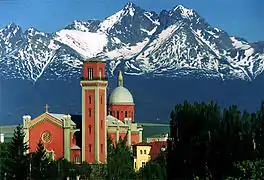 Church in Kežmarok, Slovakia | |
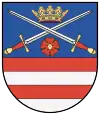 Coat of arms | |
| Etymology: "cheese market" | |
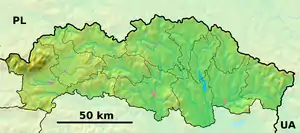 Kežmarok Location of Kežmarok in Prešov Region 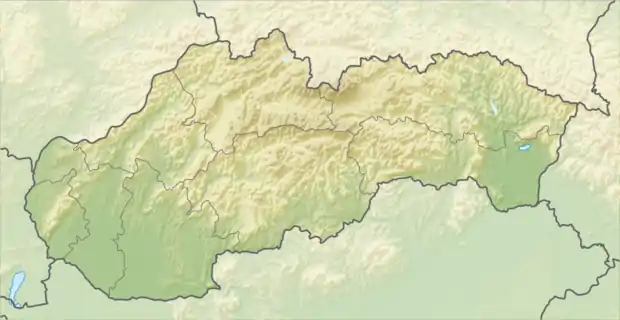 Kežmarok Location of Kežmarok in Slovakia | |
| Coordinates: 49°08′01″N 20°25′35″E | |
| Country | |
| Region | Prešov |
| District | Kežmarok |
| First mentioned | 1251 |
| Government | |
| • Mayor | Ján Ferenčák |
| Area | |
| • Total | 24.83 km2 (9.59 sq mi) |
| Elevation | 626 m (2,054 ft) |
| Population (2018-12-31[1]) | |
| • Total | 16,381 |
| • Density | 660/km2 (1,700/sq mi) |
| Time zone | UTC+1 (CET) |
| • Summer (DST) | UTC+2 (CEST) |
| Postal code | 06001 |
| Area code(s) | +421-52 |
| Car plate | KK |
| Website | www.kezmarok.sk |
| Sources:[2][3] | |
History
Settlement at Kežmarok dates back to the Upper Stone Age. In the 13th century the region contained a community of Saxons, a Slovak fishing village, a Hungarian border post and a Carpathian German settlement. Its Latin name was first mentioned in 1251 as Villa (Saxonum apud Ecclesiam) Sancte Elisabeth. In 1269 Kežmarok received its town charter. It also had the right to organize a cheese market (hence the German name Kesmark ("Käsemarkt" - "cheese market"). In 1433 the town was severely damaged by a Hussite raid. After 1440, the count of Spiš had a seat in Kežmarok. In the 15th century (and then once more in 1655), Kežmarok became a free royal town.
The town was a stronghold of the noble Thököly family. The Hungarian magnate and warrior Imre Thököly was born in the town in 1657. He died in exile in Turkey in 1705 but in the 20th century his body was returned to Kežmarok and he is buried in a noble mausoleum in the town's Lutheran church.
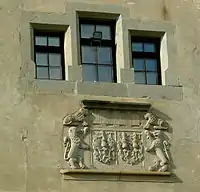
The town's other monuments include a castle, many Renaissance merchant houses, and a museum of ancient books. In pride of place is the Protestant church built in 1688 entirely of wood. The church also contains an organ of 1719 with wooden pipes. The church has been a UNESCO World Heritage Site since 2008.
Kežmarok had an ethnic German majority until around 1910, and Germans stayed a large minority until the end of World War II. It also had a large and active Jewish community. During World War II, under the auspices of the First Slovak Republic, nearly 3,000 of the town's Jews were deported to German death camps. The town's pre-war Jewish cemetery has now been restored.
Monuments
The town contians many historic monuments, including the Basilica of the Exaltation of the Holy Cross and the Wooden articular church in Kežmarok.
Demographics
According to the 2001 census, the town had 17,383 inhabitants. 95.21% of inhabitants were Slovaks, 1.59% Roma, 0.83% Czechs and 0.43% Germans.[4] The religious makeup was 77.50% Roman Catholics, 10.98% people with no religious affiliation, 4.83% Lutherans and 2.63% Greek Catholics.[4]
Twin towns — sister cities
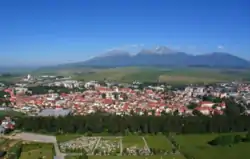
Personalities
- Vojtech Alexander, radiologist
- Ľuboš Bartečko, ice hockey player
- Karl Sovanka, painter and sculptor
- Radoslav Suchy, ice hockey player
- Imre Thököly, Prince of Transylvania
- Juraj Herz, film director
- Sámuel List medical doctor at Trnava University 1777.[6] Possible relative To Franz Liszt
- Milan Lach, Bishop/Eparch of Parma
Gallery
 Town hall
Town hall Protestant church
Protestant church Railway station building
Railway station building Reduta, former city library
Reduta, former city library Houses at Starý trh (Old Market)
Houses at Starý trh (Old Market) Wooden articular church
Wooden articular church
References
- Notes
- "Population and migration". Statistical Office of the Slovak Republic. Retrieved 2019-04-16.
- The Town Kežmarok Archived September 28, 2007, at the Wayback Machine
- Mestská a obecná štatistika SR Archived October 6, 2007, at the Wayback Machine
- "Municipal Statistics". Statistical Office of the Slovak republic. Archived from the original on 2007-11-16. Retrieved 2007-12-15.
- "Partnerské mestá". kezmarok.sk (in Slovak). Kežmarok. Retrieved 2019-09-05.
- Szinney József, Magyar írók élete és munkái, Hornyánszky Budapest 1900
| Wikimedia Commons has media related to Kežmarok. |
Genealogical resources
The records for genealogical research are available at the state archive "Statny Archiv in Levoca, Slovakia"
- Roman Catholic church records (births/marriages/deaths): 1674-1919 (parish A)
- Greek Catholic church records (births/marriages/deaths): 1765-1925 (parish B)
- Lutheran church records (births/marriages/deaths): 1601-1897 (parish A)
External links
| Wikivoyage has a travel guide for Kežmarok. |